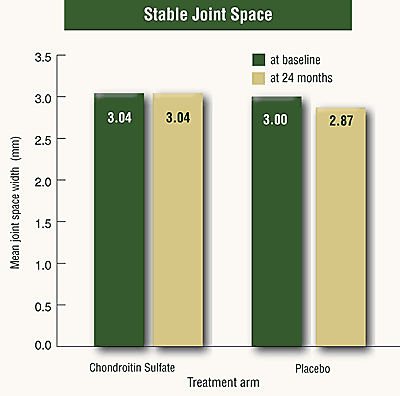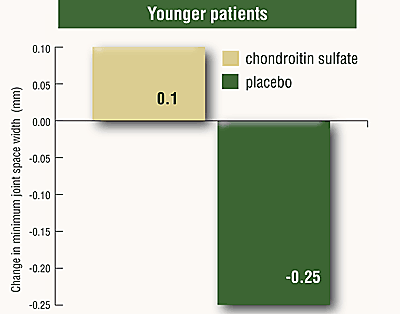Chondroitin sulfate provides joint space width stabilization
Mean and minimum joint space narrowed with placebo but remained stable with chondroitin sulfate, researchers say.
|
|
Chondroitin sulfate is effective for joint space width stabilization when analyzing the radiological progression of knee osteoarthritis. The drug therefore qualifies as a Disease Modifying Osteoarthritis Drug (DMOAD) and has produced interesting results in groups of special interest.
Model for DMOAD efficacy evaluation
I recently led a study to assess the effect of chondroitin sulfate on radiological progression of knee osteoarthritis.1 We used a randomized, double-blind, two-year prospective trial of chondroitin sulfate vs. placebo.
Inclusion criteria were clinical. Patients had radiographic osteoarthritis of the knee, as diagnosed according to American College of Rheumatology criteria.
Excluded patients were younger than 40 years or older than 85 years. Other exclusion criteria included Kellgren and Lawrence grade-4, secondary osteoarthritis, severe comorbidities, chondroitin sulfate hypersensitivity, joint surgery in the six months preceding the start of the study or major surgery foreseen in the two years following the study.
We studied patients at 0, 12 and 24 months. Patients received follow-up questionnaires every three months and underwent X-rays at month 0 and month 24.
|
|
Figure 1. The mean joint space width decreased significantly |
Primary efficacy outcome criteria included analysis of the quantitative change in radiology, especially the femorotibial joint space of the target knee defined as the most symptomatic upon entry.
Our study included 300 patients; half received a placebo and half received chondroitin sulfate. The dropout rate was 27% in both groups.
Radiology is key
We performed an extended view of the standing patient’s knee as a means of determining suitability for the study. Patients presenting with calcium pyrophosphate dihydrate deposition were excluded.
For the analysis segment of the study, we employed a partial flexion view of the standing patient’s knee.
The flexion view is obtained by bending the patient’s knee 20°, aligning the patient’s toes with the cassette, ensuring the knee rests against the cassette, with the X-ray taken at a 5° downward angle. We drew a foot map at the initial measurement and used it again at the two-year measurement to ensure congruence.
The chondroitin sulfate group showed an insignificant difference between minimum joint space width measurements at 0 months and 24 months: 2.41 mm vs. 2.45 mm, respectively.
The difference in minimum joint space width over the same period in the placebo group was significantly different, decreasing from 2.35 mm to 2.28 mm.
The difference in minimum joint space width between the placebo and chondroitin sulfate groups was significant (P = .05).
We observed similar results in the mean joint space width outcome measure. The mean joint space width remained constant at 3.04 mm over two years in the chondroitin sulfate group but decreased from 3 mm to 2.87 mm in the placebo group (Figure 1). The difference in mean joint space width between the placebo and chondroitin sulfate was significant (P = .04). Chondroitin sulfate appears to have some structure-modifying effect, we concluded.
Special patient populations
We also measured the change in minimum joint space width over a two-year period in obese patients, patients younger than 60 years (Figure 2) and patients with little cartilage loss.
|
Figure 2. Patients younger than 60 years experienced an increase in minimum joint space width with chondroitin sulfate but a decrease with placebo. The difference was significant (P = .001).1 |
For all special populations, changes in minimum joint space width were minimal and not significant in patients who received chondroitin sulfate. Those who received placebo experienced significant decreases in minimum joint space width.
Superior action
Chondroitin sulfate is statistically superior to placebo for minimum joint space width stabilization and mean joint space width stabilization. Chondroitin sulfate qualifies as a DMOAD and is especially active in specific patient populations, including obese patients, patients younger than 60 years and patients with mild-to-moderate osteoarthritis.
References
- Michel BA, Stucki G, Frey D, et al. Chondroitins 4 & 6 sulfate in osteoarthritis of the knee: a randomized, controlled trial. Arthritis Rheum. 2005;52:779-786.

![Beat A. Michel, MD [photo]](/~/media/images/news/print/orthopedics-today/2006/05_may/michel_70_90_16706.jpg)

